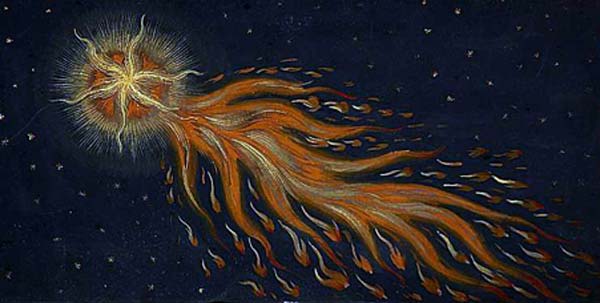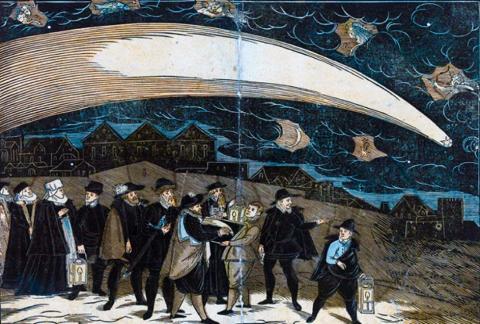To the ancients, the incredible and unfamiliar natural celestial events were interpreted through cultural understandings of the day – which is to say, they were considered divine or damning.
In antiquity, meteorites were seen as messages from the gods, or profound omens, and many cultures saw fallen meteorites as religious icons to be worshiped or as objects of protection. Jewelry and art have also been created from the space rocks.
The Greeks and Romans believed that the appearance of comets, meteors and meteor showers were portentous. They were signs that something good or bad had happened, or was about to happen.
In the spring of 44 BC, a comet that appeared was interpreted as a sign of the deification of Julius Caesar, following his murder.

"In 1007 A.D., a wondrous comet appeared. It gave off fire and flames in every direction," wrote Augsburger Wunderzeichenbuch in The Book of Miracles in the 16th century. An ancient painting of a comet with tail from The Book of Miracles. (Public Domain)
Roman historian Cassius Dio referred to “comet stars” occurring in August, 30 BC. These are mentioned as among the portents witnessed after the death of the Egyptian queen Cleopatra.
In Christian tradition, the Perseid meteor shower was connected to the martyrdom of St Lawrence in the third century AD. His martyrdom supposedly took place on August 10, when the meteor shower was at its height. The shooting stars are equated to the saint’s tears.
When Halley’s comet appeared in the night sky on the eve of the Norman invasion of England in 1066 AD, King Harald II, ruler of England, believed it was a bad omen that signaled his impending defeat. On the opposing side, William the Conqueror saw the same phenomenon as a good omen and a message from God to press on with his attack. The invasion resulted in Harold II’s death and William’s control of England.
In more recent examples, following the Tunguska meteor event of 1908, Science writer Roy Gallant traveled to the explosion site in Siberia and witnessed the effects on local beliefs with inhabitants of the area attributing the phenomenon to an appearance of their fire god.
Then, after the dramatic Chelyabinsk event over Russia in 2013, the ‘Church of the Meteorite’ was set up, and the followers hold rites on the shores of Lake Chebarkul where pieces of the space rock fell.
Top image: A depiction of the Great Comet of 1577 over Prague. In addition to the comet, five zodiac symbols appear in the sky: (L-R) Aries, Pisces, Aquarius, Capricorn, and Sagittarius. (Public Domain)




